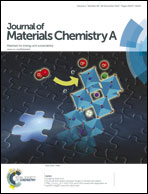Formation of internal p–n junctions in Ta3N5 photoanodes for water splitting†
Abstract
Tantalum nitride photoanodes for water splitting are fabricated by anodizing tantalum foils, with subsequent nitridation of the foils in NH3. The as-synthesized Ta3N5 film has n-type conductivity. Loading Co ions during and after the anodization process forms a Ta3N5:Co film consisting of p- and n-type Ta3N5 domains. Both the Ta3N5 and Ta3N5:Co electrodes have a band gap of 2.0 eV. The p–n junctions in the Ta3N5:Co electrode create an internal electrical field favorable for hole transfer from the n-type domains to the p-type domains. When the photoanodes are immersed in a 0.5 M KOH aqueous solution for water splitting with one-sun illumination, the Ta3N5:Co photoanode exhibits photocurrents an order of magnitude higher than those of the bare Ta3N5 photoanode. AC impedance spectroscopy analysis reveals that the p–n junctions formed by Co-doping reduce the interfacial charge transfer resistance by an order of magnitude. The diffuse reflectance spectra of the electrodes indicate that Co incorporation minimizes the defect states in the bulk Ta3N5. Intensity-modulated photocurrent spectroscopy analysis reveals that the high electron transit rate of the Ta3N5:Co electrode can be attributed to its fewer defect states. A photoelectrochemical reaction using the Ta3N5:Co photoanode produces H2 and O2 at a ratio close to 2 : 1, and N2 evolution from the reaction is negligible. The present study demonstrates the establishment of a p–n junction configuration that considerably enhances the performance of nitride anodes in photocatalyzed water splitting.


 Please wait while we load your content...
Please wait while we load your content...